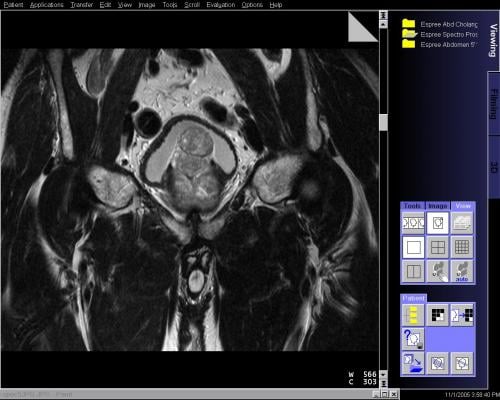
January 12, 2015 — Adding radiation treatment to hormone therapy saves more lives among older men with locally advanced prostate therapy than hormone therapy alone, according to a new study in the Journal of Clinical Oncology this week from Penn Medicine researchers.
The researchers found that hormone therapy plus radiation reduced cancer deaths by nearly 50 percent in men aged 76 to 85 compared to men who only received hormone therapy. Past studies have shown that 40 percent of men with aggressive prostate cancers are treated with hormone therapy alone, exposing a large gap in curative cancer care among baby boomers aging into their 70s.
"Failure to use effective treatments for older patients with cancer is a healthcare quality concern in the United States. Radiation plus hormone therapy is such a treatment for men with aggressive prostate cancers," said lead author Justin E. Bekelman, M.D., an assistant professor of radiation oncology, medical ethics and health policy at Penn's Perelman School of Medicine and Abramson Cancer Center. "Patients and their physicians should carefully discuss curative treatment options for prostate cancer and reduce the use of hormone therapy alone."
Locally advanced prostate cancer is cancer that has spread outside but near the prostate gland. Unlike slower growing tumors, locally advanced prostate cancer is an aggressive malignancy that is prone to metastasize and cause cancer deaths. Hormone therapy lowers or blocks the levels of testosterone and other androgens (male hormones) that feed prostate cancer tumors.
Two landmark clinical trials have shown that radiation plus hormone therapy produces a large and significant improvement in survival in younger men relative to hormone therapy alone, but until now there has been no comparable research on treatment for older men with advanced prostate cancer.
Addressing this question for the first time, Penn's research team compared the combination of radiation plus hormone therapy versus hormone therapy alone among 31, 541 men with prostate cancer ranging in age from 65 years to 85 years. Among men age 65 to 75, radiation plus hormone therapy was associated with a reduction in prostate cancer deaths of 57 percent relative to hormone therapy alone (from 9.8 percent to 4.4 percent of patients at 7 years follow up). Similarly, among men age 76 to 85, radiation plus hormone therapy was associated with a reduction in prostate cancer deaths of 49 percent relative to hormone therapy alone (from 9.8 percent to 5.0 percent of patients at 7 years follow-up). In both groups, radiation plus hormone therapy was also associated with about one-third fewer deaths from any cause.
Importantly, the clinical trials have shown that the side effects of radiation plus hormone therapy are very acceptable relative to hormone therapy alone.
"Older men with aggressive prostate cancers should know that the combination of radiation plus hormone therapy is both tolerable and effective in curing prostate cancer," said Bekelman.
In addition to offering new evidence for older men, Bekelman's research also demonstrates that the prior clinical trial findings for younger men apply in the "real-world" of routine clinical practice. Only 3 percent of cancer patients participate in clinical trials; thus, confirming that treatments work in real-world care is a crucial aspect of translating medical evidence to clinical practice.
Bekelman's study is an example of patient-centered cancer comparative effectiveness research, which provides reliable, useful information to help individual patients make informed cancer care decisions and improve cancer care outcomes.
The Penn-led study examined radiation treatment and hormone therapy in the Surveillance Epidemiology and End Results (SEER) Medicare database. SEER collects data from population-based cancer registries that cover 26 percent of the U.S. population and Medicare, which covers 97 percent of the U.S. population 65 years of age or older. Patients received treatments not by random assignment but as part of their normal clinical care. Bekelman's team utilized specialized analysis techniques to mimic randomized clinical trials in data from routine care and to identify which treatments are best for men of different age groups and cancer severity.
For more information: www.jco.ascopubs.org


 December 11, 2025
December 11, 2025 









